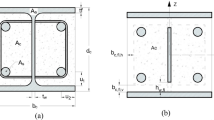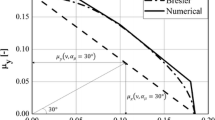Abstract
A simple design method typically applies a Fire Resistance Rating (FRR) to structural components in isolation based on their performance in the fire test. This approach naturally assumes that the interaction between these components does not degrade their fire performance. To assess the reliability of this assumption, this paper numerically investigated the fire performance of continuous steel columns, incorporating the effects coming from connected steel beams and composite slabs. A 3-step numerical validation, using ABAQUS and following a recommended general simulation process, confirmed the numerical model's accuracy for this research through agreement with experimental tests. The simulation results founded that the well-designed interior column subassemblage, T4-90, failed to reach the designed FRR. This is due to compression coming from the continuous bending beam through the beam bottom flange, significantly weakening the column performance. Rib stiffeners between column flanges are proposed to enhance resistance to contact forces from beam flanges during severe fires. However, the simulation found that the steel columns with rib stiffeners might fail immediately after reaching the FRR. Thus, this research introduced the concept of 'reserve fire resistance' (authentic fire resistance to FRR) to evaluate structural steel elements' resilience to fires exceeding the specified FRR, aligning with the concept of reserve capacity of structural resilience to earthquakes. Based on this concept, new limiting temperature design equations were proposed and validated for steel columns derived from their performance, which yielded an average reserve fire resistance of 1.30 herein.
















Similar content being viewed by others
Abbreviations
- \({A}_{i}\) :
-
Steel deck area
- \({a}_{i}\) :
-
Rebar area
- \({f}_{c}\) :
-
Compressive strength of concrete
- \({f}_{y}\) :
-
Yield strength of reinforced bar
- \({d}_{r}\) :
-
Bar diameter
- \({D}_{s}\) :
-
Slab depth
- \({D}_{p}\) :
-
Height of steel decking
- \({f}_{y}\) :
-
Yield strength of structural steel
- \({f}_{u}\) :
-
Ultimate strength of structural steel
- \({L}_{e}\) :
-
Column effective length
- \({M}_{b,f}\) :
-
Member moment capacity in fire
- \({M}_{b,f}^{*}\) :
-
Imposed moment in fire
- \({\mathrm{N}}_{\mathrm{c},\mathrm{f}}\) :
-
Member compression capacity
- \({\mathrm{N}}_{\mathrm{col},\mathrm{f}}^{*}\) :
-
Designed compressive load
- \({N}_{c,rib}\) :
-
The member compression capacity of reinforcing rib
- \({T}_{c}\) :
-
Steel column temperature at mid-span
- \({T}_{b}\) :
-
Steel beam temperature at mid-span
- \({T}_{lim,Des}\) :
-
The column limit temperature in design
- \({T}_{lim,FEA}\) :
-
The column limit temperature in numerical simulation
- \({\Upsilon }_{f}\) :
-
The rati o of design load to loading capacity
References
Raouffard MM, Nishiyama M (2017) Fire response of exterior reinforced concrete beam-column subassemblages. Fire Saf J 91:498–505
Ukanwa KU, Clifton GC, Lim JB, Hicks SJ et al (2018) Simple design procedure for concrete filled steel tubular columns in fire. Eng Struct 155:144–156
Albero V, Espinós A, Romero ML, Wang Y et al (2018) Interaction diagram based method for fire resistance design of eccentrically loaded concrete-filled steel tubular columns. Thin-Walled Struct 130:641–651
Meng F-Q, Zhu M-C, Clifton GC, Ukanwa KU et al (2020) Performance of square steel-reinforced concrete-filled steel tubular columns subject to non-uniform fire. J Constr Steel Res 166:105909
Laím L, Craveiro HD, Simões R, Escudeiro A et al (2020) Experimental analysis of cold-formed steel columns with intermediate and edge stiffeners in fire. Thin-Walled Struct 146:106481
Khaliq W, Kodur V (2018) Effectiveness of polypropylene and steel fibers in enhancing fire resistance of high-strength concrete columns. J Struct Eng 144(3):04017224
Wang Y, Dai X, Bailey C (2011) An experimental study of relative structural fire behaviour and robustness of different types of steel joint in restrained steel frames. J Constr Steel Res 67(7):1149–1163
Yang Y-F, Fu F (2019) Fire resistance of steel beam to square CFST column composite joints using RC slabs: experiments and numerical studies. Fire Saf J 104:90–108
Han L-H, Wang W-H, Yu H-X (2010) Experimental behaviour of reinforced concrete (RC) beam to concrete-filled steel tubular (CFST) column frames subjected to ISO-834 standard fire. Eng Struct 32(10):3130–3144
AS/NZS2327 (2017) Composite structures—Composite steel-concrete construction in buildings: New South Wales/Wellington, Australia/New Zealand
Clifton G, Abu A (2019) Fire engineering design of multi-storey steel and composite steel; concrete structures; draft demandcapacity document: recommendations and questions
AS/NZS1170.0 (2002) Structural Design Actions, Part 1: Permanent, Imposed and Other Actions. Standard Australia Limited/Standards New Zealand: Sydney
NZS3404 (2007) Part 1: Steel structures standard. SNZ Wellington, New Zealand
EN 1993-1-2 (2005) Eurocode 3: Design of steel structures - Part 1–2: General rules - Structural fire design. European Committee for Standardization: Brueeels (Belgium)
Clifton GC, Meng F, Andisheh K (2022) The slab panel method: design of composite steel floor systems for severe fires, in HERA Report R4–131: Auckland, New Zealand
ABAQUS (2017) Documentation. Dassault Systemes, Rhode Island
EN-1991-1-2 (2002) Actions on structures- Part 1–2. General actions – Actions on structures exposed to fire. European Committee for Standardization
EN-1992-1-2 (2004) Design of concrete structures—Part 1–2: General rules—Structural fire design. European Committee for Standardization.
Jiang J, Main JA, Weigand JM, Sadek FH (2018) Thermal performance of composite slabs with profiled steel decking exposed to fire effects. Fire Saf J 95:25–41
Mago N, Hicks SJ (2016) Fire behaviour of slender, highly utilized, eccentrically loaded concrete filled tubular columns. J Constr Steel Res 119:123–132
Liew JR (2008) Survivability of steel frame structures subject to blast and fire. J Constr Steel Res 64(7–8):854–866
Nguyen T-T, Tan K-H, Burgess I (2015) Behaviour of composite slab-beam systems at elevated temperatures: experimental and numerical investigation. Eng Struct 82:199–213
Mago N, Hicks S, Simms W (2016) Sequentially coupled thermal-stress analysis of a new steel concrete composite slab under fire. SESOC Journal 29(1):37
Mou B, Liu Y, Wei P, Zhao F et al (2021) Numerical investigation and design method of bolted beam-column joint panel with eccentricity in beam depths. J Constr Steel Res 180:106568
Mou B, Zhao F, Wang F, Pan W (2021) Effect of reinforced concrete slab on the flexural behavior of composite beam to column joints: Parameter study and evaluation formulae. J Constr Steel Res 176:106425
Bursi OS, Jaspart J-P (1998) Basic issues in the finite element simulation of extended end plate connections. Comput Struct 69(3):361–382
Yu H, Burgess I, Davison J, Plank R (2008) Numerical simulation of bolted steel connections in fire using explicit dynamic analysis. J Constr Steel Res 64(5):515–525
Meng F (2023) The performance of steel beam to column gravity frame subassemblages with composite slabs in severe fires in multi-storey buildings. Dissertation. The University of Auckland
Ramesh S, Ramesh S, Choe L, Seif M, et al (2019) Compartment fire experiments on long-span composite-beams with simple shear connections part 1: Experimental design and beam behavior at ambient temperature. US Department of Commerce, National Institute of Standards and Technology
Choe LY, Ramesh S, Hoehler MS, Seif MS, et al (2019) Compartment fire experiments on long-span composite-beams with simple shear connections, part 2: test results. US Department of Commerce, National Institute of Standards and Technology
Li G-Q, Wang P, Wang Y (2010) Behaviour and design of restrained steel column in fire, Part 1: fire test. J Constr Steel Res 66(8–9):1138–1147
EN-1363-1 (2012) Fire resistance tests General requirements, BSI Standard
Author information
Authors and Affiliations
Corresponding author
Ethics declarations
Conflict of interest
The authors of this manuscript certify that they have NO affiliations with or involvement in any organization or entity with any financial interest (such as honoraria; educational grants; participation in speakers’ bureaus; membership, employment, consultancies, stock ownership, or other equity interest; and expert testimony or patent-licensing arrangements), or non-financial interest (such as personal or professional relationships, affiliations, knowledge or beliefs) in the subject matter or materials discussed in this manuscript.
Ethical Approval
Hereby, we consciously assure that for the present manuscript the following is fulfilled: (1) This material is the authors’ own original work, which has not been previously published elsewhere. (2) The paper is not currently being considered for publication elsewhere. (3) The paper reflects the authors’ own research and analysis in a truthful and complete manner. (4) The paper properly credits the meaningful contributions of co-authors and co-researchers. (5) The results are appropriately placed in the context of prior and existing research. (6) All sources used are properly disclosed. (7) All authors have been personally and actively involved in substantial work leading to the paper, and will take public responsibility for its content.
Informed Consent
This research work does not involve human or animals.
Additional information
Publisher's Note
Springer Nature remains neutral with regard to jurisdictional claims in published maps and institutional affiliations.
Rights and permissions
Springer Nature or its licensor (e.g. a society or other partner) holds exclusive rights to this article under a publishing agreement with the author(s) or other rightsholder(s); author self-archiving of the accepted manuscript version of this article is solely governed by the terms of such publishing agreement and applicable law.
About this article
Cite this article
Meng, FQ., Clifton, G.C., Abu, A. et al. Numerical Study on Reserve Fire Resistance of Continuous Steel Columns in Buildings. Fire Technol (2023). https://doi.org/10.1007/s10694-023-01510-8
Received:
Accepted:
Published:
DOI: https://doi.org/10.1007/s10694-023-01510-8




